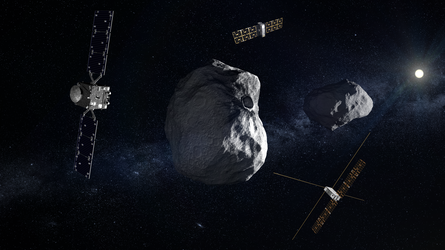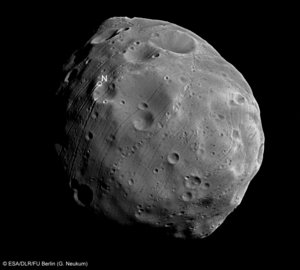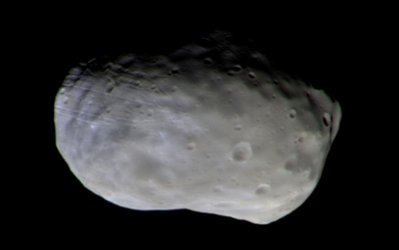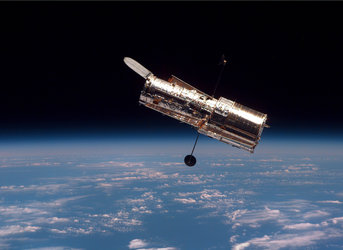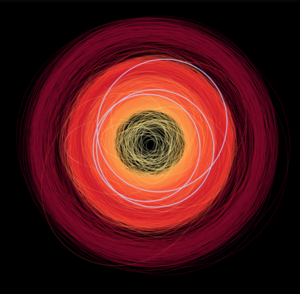Asteroids, comets and moons
We have learned a lot from visiting the Moon, and even more from other planets, but what about the thousands of other small objects that share our Solar System? Space agencies have sent several spacecraft to asteroids, comets, dwarf planets and small moons, and have ambitious plans to send more in the future.
Asteroids and comets are believed to be leftover debris from the formation of the Solar System, meaning they can help trace its history. What’s more, these objects may have played a vital role in the development of our planet and terrestrial life by colliding with Earth in catastrophic impact events, bringing life-sparking organic compounds. Such collisions were more common in the early Solar System, but small objects can still impact Earth today, damaging life, nature and infrastructure.
These objects may also have brought organic matter to other planets and moons, some of which – Jupiter’s moon Europa or Saturn’s moon Enceladus, for example – may possess the right conditions for hosting some form of life.
For all these reasons, and many more, it is important to study these objects and find out more about them.
What has Discovery & Preparation done in this area?
Laying the groundwork for ESA’s future activities, Discovery & Preparation supports exploratory research into new concepts. Several studies have investigated different elements of possible future missions to explore small extraterrestrial objects.
Asteroids and comets whose orbits come close to or even cross that of Earth are known as near-Earth objects (NEOs), and they can pose an impact threat. To mitigate this threat, the first step is to search for NEOs and map their orbits. Discovery & Preparation supported a study that explored using star trackers – already on board many spacecraft for orientation calculation – to search for NEOs. Another aimed to improve our knowledge of the locations, sizes and shapes of NEOs, by watching for when they crossed in front of a visible star, momentarily blocking the starlight.

Another challenge we face from extraterrestrial objects is that dust on their surfaces may affect visiting spacecraft, landers and astronauts. The Dusty Plasma Environments study was the first step in developing a set of models that could assess the effects of dusty plasma on future exploration units.
Recent exploration probes and rovers host mini laboratories for in-situ research, but sophisticated laboratories on Earth can perform even more advanced tests. One Discovery & Preparation study explored how to set up a facility on Earth that could safely handle such precious and potentially hazardous samples that were brought back from these space rocks. The investigation was based on previous Mars sample return facility studies.
Another study explored how to land safely on a low-gravity object. It was carried out primarily by the German Aerospace Center (DLR), who developed the MASCOT lander for the Japanese Hayabusa2 asteroid mission. The study looked into developing a second lander, MASCOT-2, designed to land on Dimorphos – one half of the double asteroid target of ESA’s Hera mission.
Due to be launched in 2024, Hera is one of Discovery & Preparation’s great success stories. The mission design was possible thanks to numerous studies, many of which are highlighted in the timeline below.
Hera will steer itself towards Dimorphos via a similar approach to self-driving cars. The spacecraft will fuse data from different sensors to build up a model of its surroundings and make decisions onboard, all independently. Autonomous vision-based navigation is already in action in several ESA missions. A Discovery study went a step further, developing a technique that would let missions like Hera fly over an unknown terrain and achieve better navigation performances based on unknown feature tracking.
Hera will host two CubeSats that will be able to get closer to Dimorphos. Being versatile, small and relatively cheap, many Discovery & Preparation studies have investigated how CubeSats could be used to explore smaller space objects. Several of these studies focused specifically on Hera’s companions.
As a first test of planetary defence, Hera has undergone many iterations. Based on these lessons learned, a recent Discovery study concluded that in an emergency situation it could be possible to develop and launch an asteroid deflection mission in just six months, if certain prerequisites are prepared well in advance.
Once we’ve found out more about asteroids, comets and moons, we may start thinking about using the rich diversity of material we find there as energy sources or a means to sustain human life as we venture deeper into space. A recent study compiled a list of potential space resource utilisation missions, performed preliminary risk analyses and proposed a risk assessment methodology. A very forward-thinking study even explored how astronauts could use ESA’s Neutral Buoyancy Facility to train for trips to these interplanetary objects, where gravity would be present but very weak.
More Discovery & Preparation activities focusing on asteroids, comets and moons can be found in ESA’s Nebula Library of studies.

What else is ESA doing?
Hera now falls under ESA’s Space Safety activities, which enable Europe to understand and minimise the dangers of risky asteroids, extreme solar events and space debris. The Planetary Defence Office observes near-Earth objects, predicts their orbits, produces impact warnings when necessary, and is involved in potential mitigation measures.
In 2014, ESA made history by orbiting a comet with the Rosetta mission. Remaining with Comet 67P/ Churyumov-Gerasimenko for over two years, Rosetta found out a plethora of information about periodic comets, and even released a lander to get closer to the surface of this mysterious object.
Next, ESA has its eyes on an asteroid. The Agency is working on the Miniaturised Asteroid Remote Geophysical Observer (M-ARGO) mission, planned for launch in the 2026–27 timeframe. M-ARGO – a 12-unit CubeSat with its own electric propulsion system – is designed to be the first ever nanosatellite to rendezvous with an asteroid. Originally studied in 2017 in ESA’s Concurrent Design Facility with support from Discovery & Preparation, the project and the numerous miniaturised technology developments are now being funded though ESA’s General Support Technology Programme (GSTP).

ESA is already involved in asteroid research, through testing three grains of rock brought back from asteroid Itokawa by Japan’s Hayabusa mission. This is contributing to our knowledge about the surface environment of asteroids, including offering insight into how the surface of asteroid Didymos responded to impact by DART.
Looking further ahead, in 2029 ESA will launch Comet Interceptor, a mission that will wait in space for a suitable comet to pass by, then fly over and surround it with three spacecraft. Comet Interceptor is based on the same satellite platform as Hera.
Planetary missions are also contributing to our understanding of extraterrestrial objects. Whilst orbiting Mars with Mars Express and the ExoMars Trace Gas Orbiter, ESA has observed Mars’ moons, Phobos and Deimos. Moving further afield, the Jupiter Icy Moons Explorer (Juice) mission will investigate four of Jupiter’s largest moons – Ganymede, Europa, Callisto and Io – to determine whether any of them have ever had conditions suitable for life.

But we don’t necessarily need to get close to these objects to learn about them. ESA’s space telescopes, including Hubble and Webb, have photographed from a distance numerous small bodies throughout the Solar System to discover more about their characteristics and orbits. Hubble captured an image of a rare self-destructing asteroid, Gaia collected information on more than 14 000 asteroids, Herschel discovered water vapour around dwarf planet Ceres, and the Infrared Space Observatory discovered twice as many asteroids as were previously believed to exist.
What are other space agencies doing?

Aside from landing on two different asteroids with their Hayabusa and Hayabusa2 missions, JAXA is currently planning a mission to survey Mars’ two moons: Phobos and Deimos. The mission, Martian Moons eXploration (MMX), even plans to collect a sample from Phobos and bring it back to Earth. The Japanese space agency is also planning the Destiny+ mission to fly by a few asteroids to understand the origin and nature of dusts, which are key sources of organic compounds to Earth.
NASA is another space agency taking a closer look at these ‘ingredients for life’. The agency is currently developing the Lucy mission, which will explore a specific group of asteroids that likely have different blends of the Solar System's starting materials than other asteroids we've previously visited. This year, NASA is launching the Psyche mission to a metal asteroid thought to be an exposed core of a planet that didn't fully form.
NASA has also visited extraterrestrial objects in the past, with the Dawn mission being the first to orbit a dwarf planet (Ceres) and also visiting the biggest asteroid in the Asteroid Belt (Vesta). Dawn discovered that Ceres was previously an ocean world and found organic material. It also confirmed that Vesta is the source of many meteorites found on Earth.
The US Stardust mission collected dust from comet Wild-2, which indicated that comets may have formed very differently than was originally believed. Deep Impact also visited a comet – Temple 1, crashing an impactor into the comet’s surface to expose materials such as water ice and organic matter. These results suggest that comets may have played an essential role in the initiation of life on Earth.

Right now, NASA’s NEOWISE mission is orbiting Earth, sweeping the sky looking for asteroids. Meanwhile, the OSIRIS-REx spacecraft is on its way back to Earth after visiting asteroid Bennu. OSIRIS-REx is bringing back a sample to Earth to support investigations into how planets formed and life began. The Canadian Space Agency (CSA) participated in OSIRIS-Rex by providing an instrument that mapped the asteroid’s surface, allowing scientists to select a suitable sample site. CSA also developed the Near-Earth Object Surveillance Satellite (NEOSSat), dedicated to detecting and tracking asteroids that may someday pass close to Earth.
And it’s not only space agencies that are involved in finding out more about NEOs – the European Southern Observatory (ESO) also dedicates time to this cause. In 2019, ESO’s Very Large Telescope imaged a double asteroid that came close to Earth. This provided a good opportunity to rehearse how space organisations would work together if a hazardous NEO ever threatened Earth directly. The project was coordinated by the International Asteroid Warning Network (IAWN), a collaboration between many space organisations aiming to protect Earth from NEOs.
Last updated 14 August 2023.















 Germany
Germany
 Austria
Austria
 Belgium
Belgium
 Denmark
Denmark
 Spain
Spain
 Estonia
Estonia
 Finland
Finland
 France
France
 Greece
Greece
 Hungary
Hungary
 Ireland
Ireland
 Italy
Italy
 Luxembourg
Luxembourg
 Norway
Norway
 The Netherlands
The Netherlands
 Poland
Poland
 Portugal
Portugal
 Czechia
Czechia
 Romania
Romania
 United Kingdom
United Kingdom
 Sweden
Sweden
 Switzerland
Switzerland
























